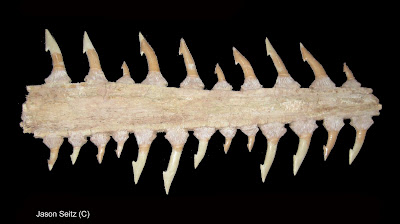Two sawfish species – the smalltooth and largetooth sawfishes (Pristis pectinata and P. pristis) – are known to have occurred
historically in Caribbean and Central American (Atlantic) coastal seas, whilst
only the largetooth sawfish is known from the eastern Pacific. The current status
of sawfishes in the waters of Mexico, Central America and the west coast of
South America is poorly understood. Until recently, little up-to-date information
was available from these regions but happily, since 2014, numerous research
projects have developed to address these data gaps. Many of these projects are
multi-country collaborative efforts, which facilitates the sharing of resources
and expertise. In my role as Sawfish Conservation Coordinator for the IUCN Shark Specialist Group, I recently compiled information about the sawfish research projects underway in Mexico, Mesoamerica and South America, and put the various researchers and teams involved in contact with each other where necessary. The information I received from teams working on sawfish projects is summarised below, but if
you are working on sawfishes in these regions and don’t see your
project mentioned here, please do get in touch!
In Mexico, Océanos Vivientes AC is conducting a nationwide survey of
historical and current presence of sawfishes, in order to evaluate the
conservation status of sawfishes in Mexico. The team hopes to work towards a
change in Mexican legislation relating to sawfishes. Océanos Vivientes is also
collaborating with Conservation International to develop sawfish research in
Colombia.
MarAlliance is working in Belize, Cuba, Guatemala, Honduras and on the
Caribbean coast of Mexico. Their work on sawfishes is part of a broader programme
which involves working closely with fishing communities to monitor marine
megafauna, especially elasmobranchs. They hope to assess the current existence
of sawfishes in each of their study regions, document historical occurrence,
distribution and local uses of sawfishes, and identify strategies to encourage
the recovery of any remaining sawfish populations.
 |
| A largetooth sawfish (c. 5.6 m total length) captured off northern Peru, and released alive, in February 2015. |
 |
| Dr. Rosas-Luis interviewing fish vendors in northern Peru. |
Fundación Talking Oceans and the Smithsonian Institution is conducting
sawfish research in Costa Rica, Panama, Colombia and Ecuador. They aim to assess
the current distribution and conservation status of sawfishes in the ETP, as
part of a wider project to identify and map elasmobranch critical habitats and assess
MPA effectiveness. Fundación Talking Oceans are working with a number of
collaborators including Marviva, WWF, USAID-BIOREDD, Universidad de Costa Rica,
Playa Tortuga, Malangwai, SINAC, PRETOMA, Universidad de Panama, ARAP, Planeta
Océano and NAZCA.
 |
| Juliana Lopez Angarita and a fisherman with a sawfish rostrum from a market in Costa Rica. Photograph (c) Alex Tilley. |
 |
| Cock-fighting spurs made from plastic composites. |
Many thanks to all the researchers who provided details of their projects for this article, and to the many funders supporting this much-needed work.
This article first appeared in the IUCN SSG's newsletter, 10th November 2015.










